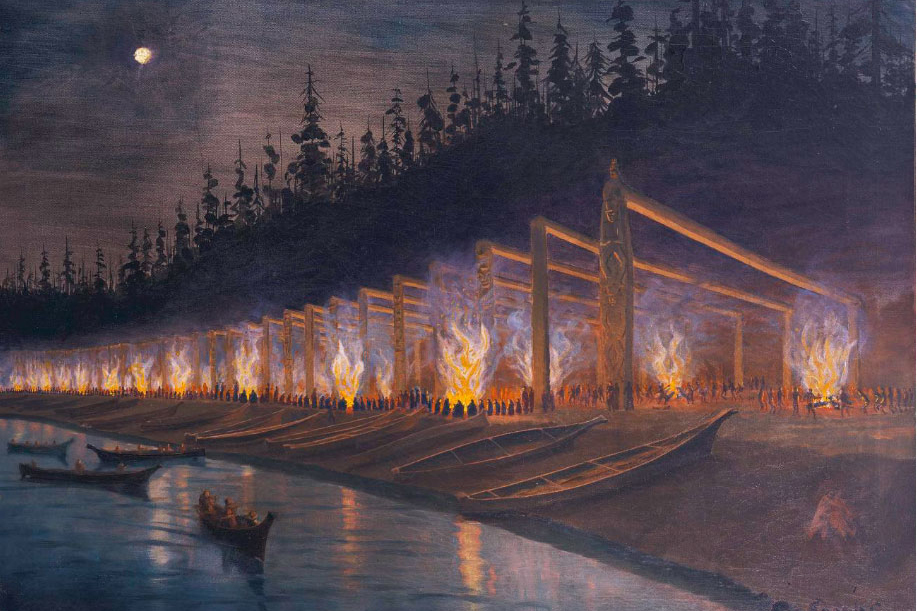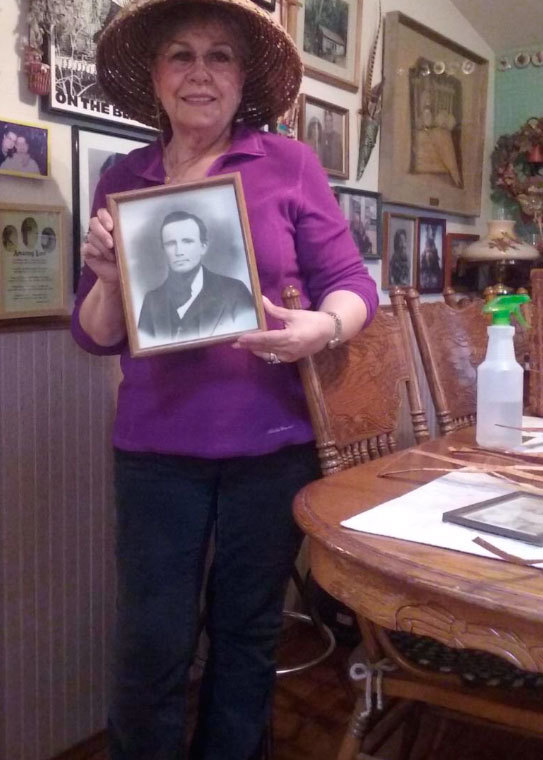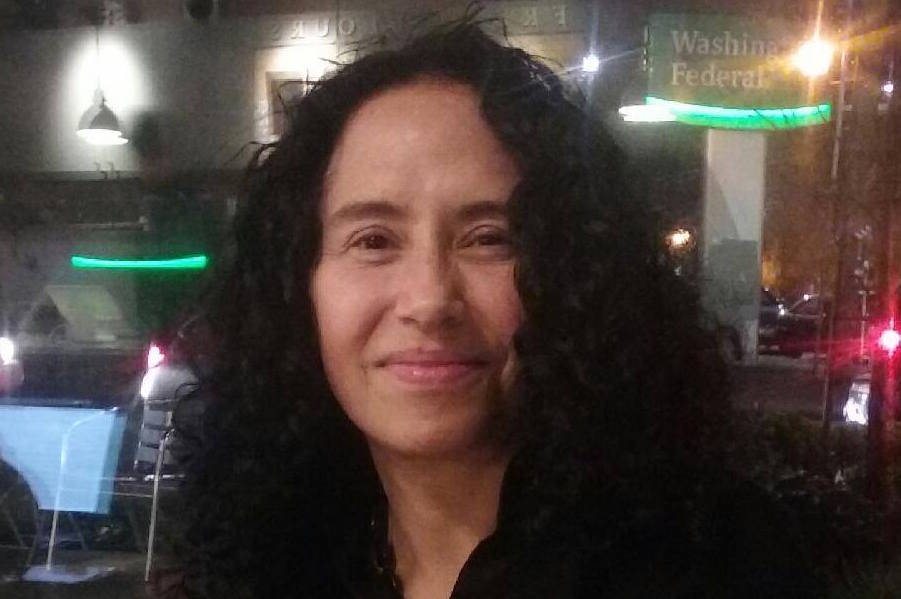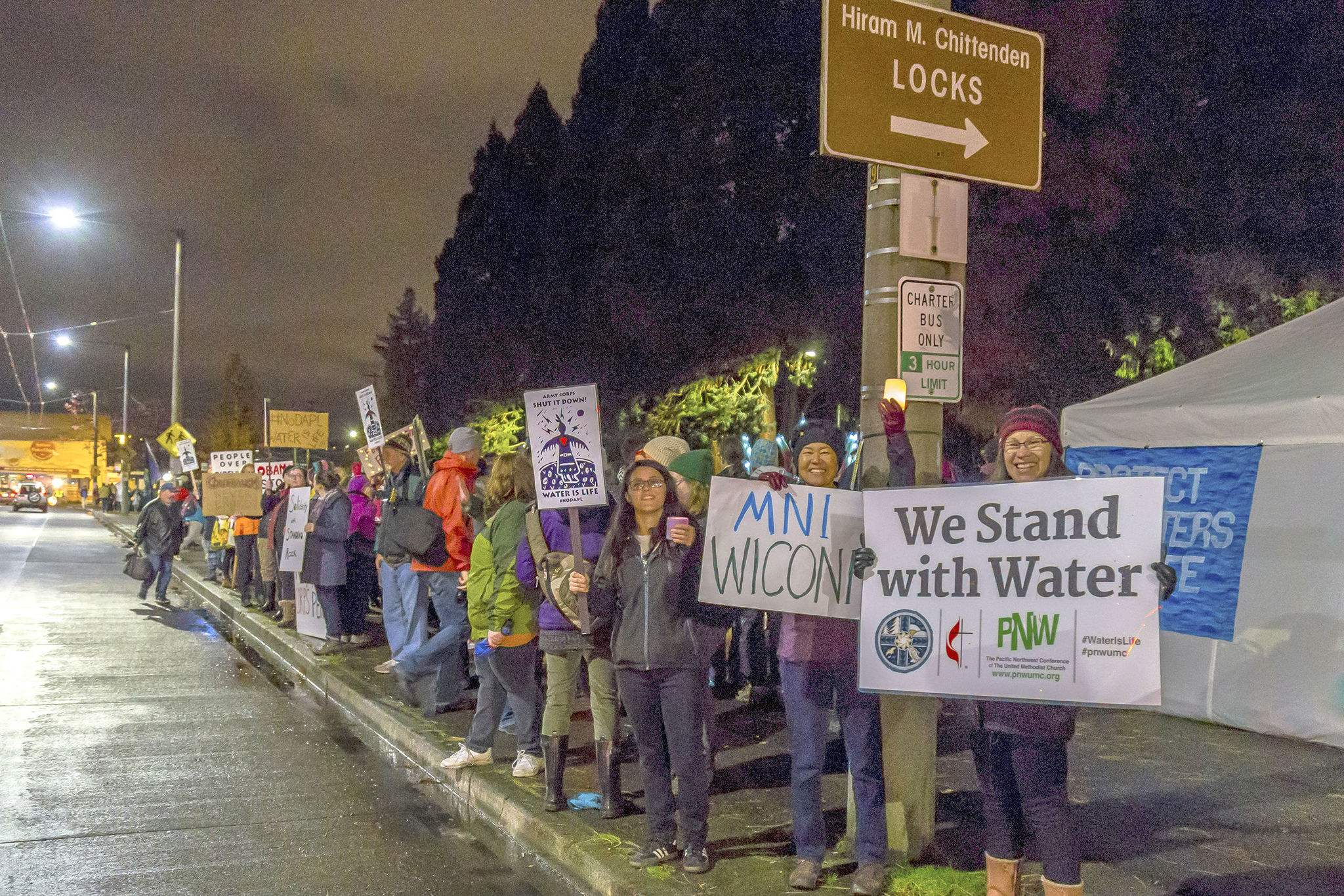Two years after WWII, at the Kitsap County Fair, there was a wooden pillar on display from Chief Seattle’s long-gone lodge house, Old Man House, which was located near the present-day town of Suquamish.
Around the pillar were photos of Chief Seattle’s descendants. A third-grade teacher at the fair recognized one of her students in a photo, posing next to her much more Native-looking grandmother. The next day in class the teacher announced that they had a celebrity in their midst. Chief Seattle’s great-great-great-great-granddaughter looked around the class wondering who it could be.
At the time, Mary Lou Slaughter was only vaguely aware of her native ancestry, and looked like any other brown-eyed white girl. When the teacher announced in front of everybody that she was Chief Seattle’s descendent, her classmates fawned over her for about five minutes. Then the bell rang. Outside the classroom, the other kids chased her home calling her “dirty old Indian” and spitting on her. She locked the door behind her and fell down crying. When her mother asked her what was wrong, Mary Lou lashed out at her, saying, “I’m not Indian like you. I’m Swede like my daddy.” Her mother told her that she didn’t get her brown eyes from her Swede daddy. Mary Lou said she wanted blue eyes. Her mother told her to just be glad she could see out of them. That was the end of the conversation. But it was the beginning of Mary Lou’s biracial identity, a condition one member of the Duwamish tribe called “having a leg in two canoes.”
The phrase was certainly applicable to Mary Lou’s lineage. Because one thing that Mary Lou’s teacher didn’t learn at the Kitsap County Fair was that Mary Lou was a sort of double celebrity. In addition to being descended from Chief Seattle, she is also descended from the white man who burned Old Man House to the ground: William DeShaw.
Originally from Galveston, Texas, William Upenshaw moved to the Puget Sound area two years before the Civil War, under mysterious circumstances, and changed his last name to DeShaw in order to make it harder for his enemies to track him down in the Northwest wilderness. Despite wearing Apache and Comanche scalps on his belt, harvested from people he claimed to have killed on the Texas frontier, William DeShaw struck up a close friendship with Chief Seattle by being one of the few white people who learned to speak the Chief’s native Lushootseed. In Chief Seattle’s family, speaking anything other than Lushootseed was regarded as vulgar. The friendship eventually led to DeShaw marrying Chief Seattle’s granddaughter, and the couple lived together at DeShaw’s store, the Bonanza Trading Post, directly across the water from Old Man House, on Bainbridge Island.
When Chief Seattle died in 1866, it was DeShaw who paid for his funeral. Shortly after the funeral, the U.S. government made DeShaw the U.S. Indian Agent at what was then referred to as the “Old Man House” Reservation. One of his first acts as agent was to see to it that the lodge was destroyed. In 1870 he did just that, burning the lodge to the ground in hopes of moving the 600 to 800 inhabitatants there to single-family homes.
The federal government had never liked Old Man House. It was one of the largest structures ever built by a North American Indian civilization, taking up a section of beach the size of the Goodyear Blimp, at 200 feet long by 100 feet wide. The Bureau of Indian Affairs believed that buildings like Old Man House encouraged communism among the Indians, because it served as a home to hundreds of Puget Sound natives, and took away their incentive to work. Decades later The Seattle Star ran a local history column for children that explained the torching of Old Man House to children this way: “It was not right or best for so great a number of people to live in one great house. So Mr. DeShaw himself built for an Indian family a little home such as white people have and taught them how to live in it.”
The part about DeShaw building a house was true, but only to an extent. While one Indian family did indeed move into the house DeShaw built for them, the majority of the tribe had no interest in restructuring their lives around white customs. For decades after the torching of Old Man House, the Suquamish continued to camp in its burned out ruins beneath the lone remaining rafter. DeShaw chalked up all cultural differences to racial inferiority, complained that so much reservation land was wasted on Indians, and soon resigned his position and went back to running his store.
In addition to the trading post, DeShaw developed a successful smoked salmon business on Bainbridge—much of which he exported to San Francisco. The 1880s turned out to be a great time to run an export business in the Northwest, with Seattle becoming one of the major West Coast ports.
But success did not free him from his mysterious past. Strange characters from all over the world wound up popping into DeShaw’s store to look at his vast collection of native artifacts and hear him talk about his adventures. And he often suffered paranoid episodes in which he was sure someone was out to kill him.
He would draw the curtains, baracade the door and pace around with a loaded gun in his hands. What exactly DeShaw did to get himself kicked out of Texas and fear for his life can only be guessed at. The most promising clues are connected to two items DeShaw brought with him when he moved to the Puget Sound area. One is a Mexican Army Officer’s uniform, complete with gold epaulettes, which DeShaw would wear from time to time. The other is a mysterious blue flag with a red star in the center, which once flew over the head of an American soldier of fortune named William Walker. Back in the mid-19th century, when borders were looser and governments were weaker, there were people called filibusterers who tried to take over foreign countries with their own private armies, often backed by American business interests. Walker’s plan was to seize Baja California from Mexico and set up a pro-slavery republic, which would later join the United States and shift the balance of power in to the South in the years before the Civil War. According to The Tragic Trader of Agate Point, a short biography of DeShaw written in the mid-20th century when it was still possible to interview old residents who knew DeShaw personally, it was widely believed that DeShaw wound up turning against Walker once they got to Baja. This isn’t surprising, as most of Walker’s mercenary army wound up deserting when they realized that the Mexican army, bandits, and Apache Indians who occupied Baja at the time were harder to fight than they expected. What exactly DeShaw did after this adventure is unknown, but it is likely that he joined the Mexican army, which would explain why he had a uniform that fit, and why in his ledger books he frequently entered dates and small notes in Spanish instead of English.
If William Walker was the person who DeShaw worried was coming to kill him, then the fear was unfounded. In 1860 Walker wound up being executed by firing squad in Honduras after an even more botched plan to take over that country. Of course Walker was just one of DeShaw’s many enemies.
In the summer of 1890, while on a trip to Seattle with his grandson, DeShaw collapsed on the sidewalk and started convulsing until the police arrived to help. The secret of a lifetime was finally out. Now everybody in the city knew he had epilepsy. “AN INSANE KITSAP MERCHANT,” the headline in the next day’s Seattle P-I read.The story stated that one of the wealthiest men in the region was “not in a fit mental state to be at large.” To say that epilepsy was stigmatized in the 19th century is like saying that Indians were not quite treated equally to whites. Even among the educated, it was thought of as a disorder along the lines of schizophrenia. A few months after his seizure downtown he was arrested for insanity, and put on trial to be shipped off to an asylum.
William DeShaw was definitely eccentric, but people with severe mental illnesses don’t usually master multiple foreign languages or make fortunes out of nothing when they start over under fake names. After undergoing a humiliating trial in which his own daughter, Alice, sided with his those who wanted him put away, and his oldest friends had to be brought in to testify that he was sane, DeShaw was finally released. He was quick to see a consipracy afoot the trial. In a letter to the Seattle P-I signed ‘William DeShaw, the Alleged Madman,’ DeShaw explained that years earlier he signed as the witness to a will worth $1.5 million in property bought by the railroad. Now that the will was being contested, and DeShaw was the only living witness, a plot had formed to take advantage of his epilepsy to have him committed so he could be discredited. With the conspiracy foiled DeShaw returned to his store.
In 1893 America suffered one of the worst depressions in its history. In a rebuke of the belief of Sen. Henry Dawes that the Indians needed to be forced to embrace “selfishness, which is at the bottom of civilization,” mindless self-interest and short-term financial decisions had totally ruined the economy. Wheat prices crashed, banks folded, unemployment reached 35 percent in New York, 43 percent in Michigan. Racists, Indians, doctors, epileptics, farmers, and criminals all found themselves united as they watched their money vanish and work dry up. With San Francisco no longer importing smoked seafood, DeShaw found himself being destroyed by the same system he thought the Indians were inferior for not wanting to embrace. Throughout the late 1890s his days were spent in slippers, wandering around his museum-like store trying to figure out a way to support his large family. His nights were spent hiding his remaining inventory so it couldn’t be seized by his creditors.
The last time his family ever saw him alive was on a winter day in 1900 when he was getting on the Seattle-bound ferry with a briefcase filled with IOUs to collect on the debts owed him by the dozens of people he’d lent money to. By 1900 Seattle was no longer the wild west. Most of the new working class immigrants to Seattle didn’t even know who Chief Seattle was and it was widely believed among newcomers that the name “Seattle” had something to do with the city being located on the sea. The working class looked on pioneer aristocracy like DeShaw not much differently than the way DeShaw’s generation looked on the Indians: as parasites standing in the way of progress. This irony was not lost on a lot of the surviving pioneers, who in their writings occasionally regretted their treatment of the natives.
When DeShaw never came back to the Bonanza Trading Post, his daughters started to worry about him and sent their husbands to the city to rescue him. After much searching they found his body in a hospital bed under the name William D. Shaw, his final alias. At first the hospital staff claimed they had no idea who he was, what happened to him, or where his briefcase filled with IOUs had vanished to. A hotel clerk had brought him to the hospital after finding him on the floor of his room speechless and dying. Eventually his sons found his briefcase but all of the IOUs and financial papers were gone. DeShaw’s family believes he was murdered by somebody who owed him money, nothing was ever proven. The problem was that so many people owed DeShaw money, and he had so many enemies, that narrowing down a suspect was impossible. He was also old, and epileptic, so he might have died of natural causes and whoever found his briefcase simply took the opportunity to get rid of their debts.
His obituaries hailed him as the Chief not only of the Suquamish but all Puget Sound Indians. The Seattle Star even called him the “New Chief Seattle,” which apparently made him more important than the “Old” Chief Seattle, since DeShaw’s grandfather-in-law didn’t even get a single obituary when he died three and a half decades earlier. Just to clear things up, another early pioneer sent this message to The Washington Historian shortly after DeShaw’s death:
“I will here state that I have been personally acquainted with the deceased William De Shaw from his arrival on the Puget Sound until his death. He never lived with the Indians, nor was he ever acknowledged by them as a chief.”
Eight months after his death his hometown of Galveston, Texas was literally blown off the face of the Earth by a hurricane which still holds the record for deadliest natural disaster in American history, leaving up to 12,000 people dead and destroying any records which might have existed of DeShaw back when his last name was still Upenshaw.
Still, what is known about DeShaw is plenty legendary. He was a distinctively American individual in both his good qualities, and bad. When he was born, in 1834, Texas was still part of Mexico, and the Puget Sound was still part of Canada. Decades later, when he celebrated the Fourth of July by digging zigzagging troughs filled with gunpowder in the sand in front of his store, and then lighting the entire beach on fire, there was no doubt that all the land had become America.
Even though he has been dead for over a hundred years his legacy, and the legacy of people like him, lives on in his family and the country. Mary Lou has been proud of her native heritage ever since she had a religious experience on an Alaskan island which led her to become a world renowned basket weaver, but she is also proud to be descended from William DeShaw. Before leaving Mary Lou I had one final question for her, “what happened to his scalps?”
“They’re probably hanging on an old bedpost in somebody’s garage somewhere.”









